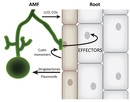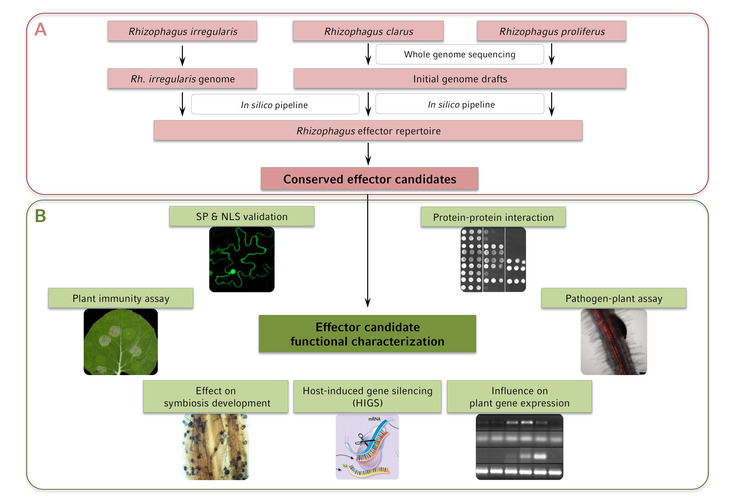Symbiotic effectors of AM fungi
The symbiosis between arbuscular mycorrhiza fungi (AMF) and plants persisted morphologically unchanged throughout the evolutionary development within the plant phylum from haploid gametophytes to diploid sporophytes (Loreau & Naeem, 2002). The mechanism of plant infection and colonization while avoiding plant defence is ancient and conserved within AMF. Recent studies of plant-microbe interactions, involving mutualistic ectomycorrhizal fungi, exhibit striking similarities during infection and point in the same direction: genes encoding effector proteins were shown to play a key role in host colonization by controlling the plant immune system (Plett et al., 2011). Pathogen effector proteins are released to alter host cell structure and function, allowing successful infection, and suppressing the host defence response (Kamoun, 2006).
There are indications that symbiotic effectors may similarly suppress the plant immune system and affect plant colonization (Kloppholz et al., 2011). Kloppholz and colleagues discovered the AMF secreted protein SP7 with a role in fungal development within plant roots. We hypothesise that also in AM symbiosis effectors play an important role. We aim to determine a fundamental role of AMF effectors during establishment of the plant-fungus symbiosis. We want to address the following questions:
- Do the selected effectors have an effect on the AM symbiosis development by influencing the colonization level?
- Do they suppress the plant immune system thus facilitating AM fungal entry into host cell?
- Do they influence symbiosis-related gene expression of the host?
- Do they promote plant defence against pathogens (a reported feature of AM)?
- Do they exhibit host specificity?
Workflow for identification (A) and functional characterization (B) of conserved effector candidates:
References:
Kamoun S (2006) A catalogue of the effector secretome of plant pathogenic oomycetes. Annu Rev Phytopathol 44: 41-60
Kloppholz S, Kuhn H, Requena N (2011) A secreted fungal effector of Glomus intraradices promotes symbiotic biotrophy. Curr Biol 21: 1204-1209
Loreau M, Naeem SPI (2002) Biodiversity and ecosystem functioning. Oxford, Great Britain, Oxford Univeristy Press
Plett JM, Kemppainen M, Kale SD, et al. (2011) A secreted effector protein of Laccaria bicolor is required for symbiosis development. Curr Biol 21: 1197-1203



